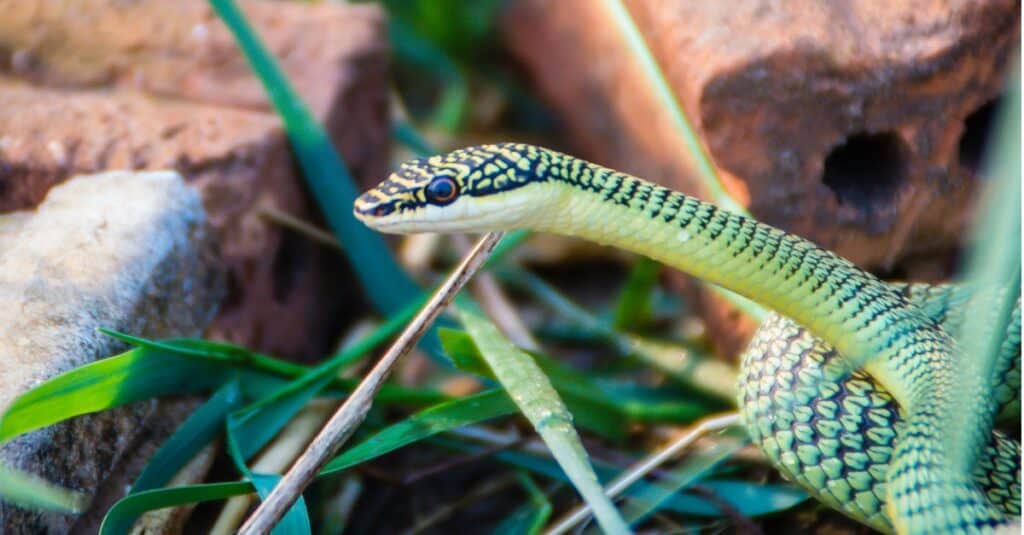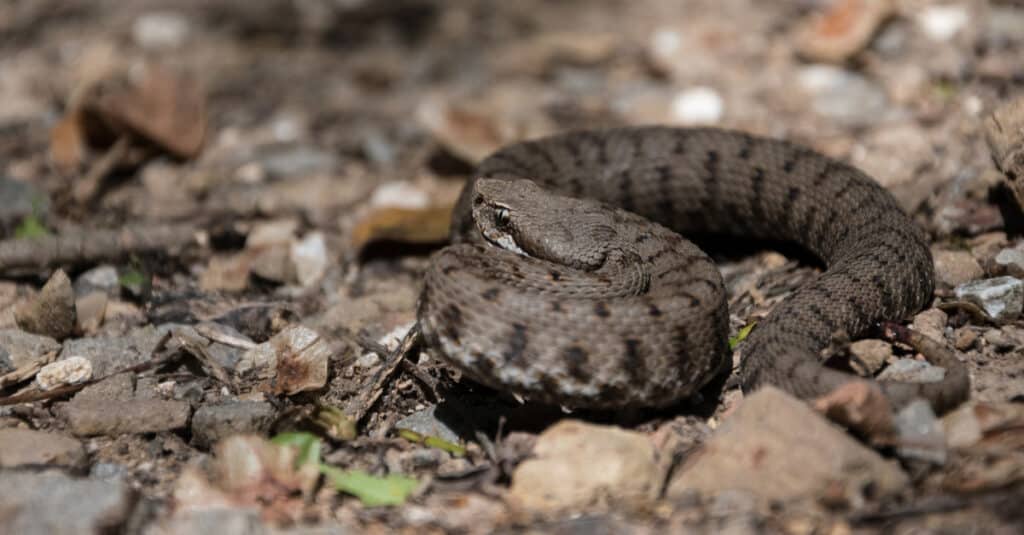Whether you’re walking on a park trail or hiking in the woods, it’s exciting to see a snake in the wild. It could be a small one slithering through a pile of leaves on its way back to its hole. Or maybe it’s a large one stretched out on a rock or taking a swim in the water of a nearby creek. Chances are when you see a snake the first thing you wonder is what kind it is. The second thing: Is it poisonous? Discover some facts on how to tell poisonous snakes from non-poisonous snakes and what’s the difference between venom and poison. Specifically, you’ll learn about the features that can help you with the identification of venomous snakes.
What is the Color of the Snake?
Colors can be useful in identifying a venomous snake. Many venomous snakes are brightly colored. This is one of those facts that’s true for many types of animals including frogs and insects. Brightly colored scales are a warning to predators that a reptile is poisonous. This is a matter of survival for this animal.
One example is the Blue Malaysian coral snake. It has dark blue or black scales featuring white stripes. Both its head and its tail are bright red. This is a small reptile from southeast Asia. It’s so poisonous that a human can die within five minutes of being bitten.
A second colorful and venomous reptile is the green bush viper from the western and central part of Africa. As its name indicates, this snake has bright green to yellowish scales. They live in trees growing in tropical forests. Their venom is very powerful and can cause death to a human if antivenom isn’t provided right away.
The boomslang is another venomous African reptile. These slithering reptiles have a green and yellow pattern of scales. They are tree-dwellers in the wild and usually try to stay out of sight. One of the most interesting facts about the boomslang is despite being venomous, it has the reputation of being a passive, shy reptile. Its bite can cause internal bleeding as well as tissue and organ damage. Antivenom is necessary for the survival of anyone who gets a bite from a boomslang.
What is Mimicry in the World of Venomous Snakes?

Often a non-venomous snake will adapt the color of a venomous snake.
©iStock.com/liveslow
When it comes to venomous snakes, mimicry is an important point to consider. Mimicry is when a non-venomous snake adapts a color or pattern similar to a venomous snake.
One example is the scarlet kingsnake. A nonvenomous scarlet kingsnake has a pattern of red, black, and yellow bands of scales. Its appearance is very similar to the poisonous eastern coral snake. An eastern coral snake has alternating bands of red, yellow, and black. There are differences between these two reptiles, but at first glance, they look a lot alike.
Other examples of mimicry in these reptiles:
- Indian wolf snake mimics the common krait
- Indian rat snake mimics the Indian cobra
There are both advantages and disadvantages for a nonvenomous reptile that mimics the colors of a venomous one in the wild. An advantage is a predator sees the bright colors of a non-venomous reptile and moves away from it thinking it is poisonous. Avoiding attacks from predators can definitely help a non-venomous reptile to survive. Alternatively, a non-venomous snake that looks similar to a venomous one may be killed by a human who thinks they’ve encountered a dangerous snake.
What is the Shape of the Snake’s Head?
A triangular head is sometimes a sign a snake is venomous. Compare the size of its head with its neck and you’ll see a notable difference in width. The copperhead is a great example of one with a triangular head.
Additional examples include water moccasins and rattlesnakes.
It is worth noting that most nonvenomous snakes also flatten their heads to achieve a similar triangular-like form in order to appear bigger than they really are.
What Kind of Eyes Does the Snake Have?
Looking at a snake’s eyes in its triangular head can help in the identification process — if you have enough light and have an understanding of the local snakes. A snake with vertical pupils in North America could be venomous, but not always. Pit vipers are venomous and have eyes with vertical pupils. The Gaboon viper, long-nose viper, and the fer-de-lance are three of the many types of vipers.
As mentioned, the eastern coral snake is a venomous reptile in North America. However, its eyes are round in shape without a vertical pupil, like other elapids. These snakes are mostly diurnal and active during the day.
Can Venomous Snakes Bite Without Releasing Their Venom?

©iStock.com/Kwhisky
Yes, a venomous snake can give a human or another animal something called a dry bite. This is a bite that doesn’t contain the venom it needs to subdue its prey. Scientists estimate that as many as 25% of snakebites can be dry.
Remember that a person isn’t able to determine whether they received a dry bite or a venomous one. So, going to a medical facility is critical to getting treatment if needed.
Are Venomous Snakes Always Large?
No. Some venomous snakes are very large while others are notably small. An eastern coral snake is one of the most venomous in North America. As an adult, it is only 18 to 30 inches long. This species is different from the venomous aquatic coral snake living in South America. It lives in the water and can grow to a length of 40 inches.
Alternatively, an adult bull snake has a thick body that can measure up to 72 inches long. Even baby bull snakes are 18 inches in length! But despite their large size, they are non-venomous. In other words, don’t judge this reptile by its size. Some of the smallest snakes have a very dangerous bite!
What Are Some Venomous Snakes in North America?
Though many types of venomous reptiles live in Africa, Australia, or South America, some live in North America as well.
The eastern diamondback rattlesnake is the largest venomous snake in North America. It weighs around 30 pounds and can grow as long as eight feet! Of course, this reptile uses its rattle as a warning to both animals and humans to keep away. However, if it does bite it has one-inch-long fangs and a powerful venom that can be deadly to a person.
The copperhead is another one of North America’s venomous snakes. It is a pit viper. This means it has a pit on each side of its head that it uses to sense the heat of warm-blooded prey. Fortunately, though this reptile’s bite is painful, it’s not usually deadly to a person.
Yellow-bellied sea snakes are commonly seen in the Pacific Ocean near Washington State, California, and down the coastline. Though they live in the water and are rarely seen, they have powerful venom. A small dose of its venom is enough to kill a human.
An adult timber rattlesnake is around ten pounds and reaches a length of up to three feet. It has a quick strike that contains a large dose of venom.
What to Do If You Encounter a Venomous Snake?

Juvenile asp viper (Vipera aspis francisciredi) in a defensive behavior.
©Claudio Pardo/Shutterstock.com
Now that you have some guidance in the identification of venomous reptiles, what do you do if you encounter one? The first thing to do is to give this slithering reptile plenty of space. Keeping your distance means the animal will feel less threatened. You’re likely to feel more at ease as well!
Keep your distance even if the snake appears to be a baby. A baby snake can be just as venomous as an adult.
Be aware of your environment. Some of these reptiles like to spend time in tall grass or weeds. So, if you can’t see where you’re stepping, go slowly and take caution. If a snake hears or feels the vibrations of people moving through their area, they are likely to seek shelter to avoid an encounter.
If you see a baby or adult venomous or nonvenomous snake on a trail or near a road, don’t try to move it. You may think you’re doing a good deed, but these reptiles have their own territory. They can become lost or confused if they are moved out of their territory. The snake is probably in that location for a reason, so it’s best to let it alone.
Keep in mind that if the reptile is in some danger of being hit by a car or is facing possible injury, call a local wildlife rescue organization. This type of organization has professionals who know how to handle a snake without being bitten or harming the reptile.
Wearing hiking boots or shoes with thick soles is always a good idea when going out to spend time in the woods. So, if you accidentally step on a reptile, your foot will be protected from a possible bite.
Venom vs. Poison: What’s the Difference?
The short answer is that venom must be injected to take effect, most venoms can be eaten with little to now effect. Poison, on the other hand, must be eaten or absorbed through the skin to take effect. However, until the last few decades, even scientists used the words poison and venom interchangeably. It wasn’t until recently that they started to separated the two, mostly in an effort be more clear in scientific literature.
Up Next…
Keep reading these posts for more incredible information about key animal facts.
- 9 Non Poisonous Snakes in the World: All that slithers is not necessarily venomous. Here are 9 reptiles with innocuous fangs.
- What Eats Snakes? 10 Animals That Eat Snakes: A fearsome reputation makes it difficult to imagine them as prey. But they are. Read about the animals which consider them just that.
- Everything You Ever Wanted to Know About Snake Eggs: They’re laid in copious quantities. Find out just how many, when they’re brought forth, and how they’re hatched.
The photo featured at the top of this post is © iStock.com/Handini_Atmodiwiryo
Discover the "Monster" Snake 5X Bigger than an Anaconda
Every day A-Z Animals sends out some of the most incredible facts in the world from our free newsletter. Want to discover the 10 most beautiful snakes in the world, a "snake island" where you're never more than 3 feet from danger, or a "monster" snake 5X larger than an anaconda? Then sign up right now and you'll start receiving our daily newsletter absolutely free.
Thank you for reading! Have some feedback for us? Contact the AZ Animals editorial team.






